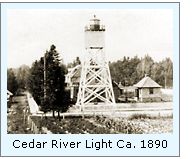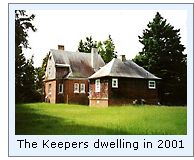|
Historical
Information

Although settlers had been living in the area at the mouth of the
Cedar River since the mid 1840's, it was not until the construction of a
steam-powered mill here in the late 1880's that the lumber boom took off
in the area, and the roving fleet of lumber hookers began tying-up at
the docks to load their decks with the forest's bounty. To serve this
increasing maritime traffic, Congress appropriated $25,000 for the
construction of a light at the entrance to Cedar River on October 2,
1888. While originally proposed as a coast light, the Lighthouse Board
determined that the area would be better served by a beacon on the
pierhead currently under construction by the Army Corps of Topographical
Engineers.
 Work on the pierhead beacon began in
September 1889. The white painted square wooden pyramidal structure,
typical of pierhead beacons constructed at that time, stood 38 feet
tall, and was exhibited for the first time on the night of November 20.
Over the following winter, plans were drawn-up for a two-story keeper's
dwelling on shore, and an elevated walk on the pier to provide the
keeper with access to the light safely above the waves which crashed
across the surface of the pier during stormy weather. Work on the pierhead beacon began in
September 1889. The white painted square wooden pyramidal structure,
typical of pierhead beacons constructed at that time, stood 38 feet
tall, and was exhibited for the first time on the night of November 20.
Over the following winter, plans were drawn-up for a two-story keeper's
dwelling on shore, and an elevated walk on the pier to provide the
keeper with access to the light safely above the waves which crashed
across the surface of the pier during stormy weather.
A site for the keepers dwelling was
donated by the Hon. Jesse Spalding of Chicago in 1890, however situated
as it was in a low and damp area, considerable grading was necessary
before the red brick dwelling could be built. A brick oil house, barn
and privy completed the station's structures.
 In 1891, a tower was constructed in
front of keepers dwelling to serve as a rear range to the pierhead
light, with the construction completed in time for display on the
opening of navigation in 1891. Work on the station, with the exception
of the sinking of a well, was completed in July of that same year, with
the well not drilled until 1895, when a 1,220 foot shaft was sunk and
plumbed into the dwelling. In 1891, a tower was constructed in
front of keepers dwelling to serve as a rear range to the pierhead
light, with the construction completed in time for display on the
opening of navigation in 1891. Work on the station, with the exception
of the sinking of a well, was completed in July of that same year, with
the well not drilled until 1895, when a 1,220 foot shaft was sunk and
plumbed into the dwelling.
With the depletion of the forests in
the area, the number of shipments began to decline during the first
decade of the twentieth century, and thus when the mill burned in 1912,
no attempt was made to rebuild the structure.
Today, Cedar River serves as a fishing
and vacation community, and the keepers dwelling is all that remains of
the light station, it's rear range tower and the bustling lumber trade
that it served merely a memory.

Keepers of this
Light

Click Here
to see a complete listing of
all Cedar River Light keepers compiled by Phyllis L. Tag of Great Lakes
Lighthouse Research.

Seeing this
Light

We have yet to visit this light, and thank Russ Babington for providing
us with the 2001 photograph of the keeper's dwelling.

Finding this
Light

The keeper's dwelling
can be seen on the east side of highway 35 on a short side street near
the mouth of the Cedar River.

Reference Sources

Annual reports of the Lighthouse Board, 1890 through 1909
Great Lakes Light Lists, 1924 & 1928
Keeper listings for this light
appear courtesy of Great
Lakes Lighthouse Research
|
 Work on the pierhead beacon began in
September 1889. The white painted square wooden pyramidal structure,
typical of pierhead beacons constructed at that time, stood 38 feet
tall, and was exhibited for the first time on the night of November 20.
Over the following winter, plans were drawn-up for a two-story keeper's
dwelling on shore, and an elevated walk on the pier to provide the
keeper with access to the light safely above the waves which crashed
across the surface of the pier during stormy weather.
Work on the pierhead beacon began in
September 1889. The white painted square wooden pyramidal structure,
typical of pierhead beacons constructed at that time, stood 38 feet
tall, and was exhibited for the first time on the night of November 20.
Over the following winter, plans were drawn-up for a two-story keeper's
dwelling on shore, and an elevated walk on the pier to provide the
keeper with access to the light safely above the waves which crashed
across the surface of the pier during stormy weather. In 1891, a tower was constructed in
front of keepers dwelling to serve as a rear range to the pierhead
light, with the construction completed in time for display on the
opening of navigation in 1891. Work on the station, with the exception
of the sinking of a well, was completed in July of that same year, with
the well not drilled until 1895, when a 1,220 foot shaft was sunk and
plumbed into the dwelling.
In 1891, a tower was constructed in
front of keepers dwelling to serve as a rear range to the pierhead
light, with the construction completed in time for display on the
opening of navigation in 1891. Work on the station, with the exception
of the sinking of a well, was completed in July of that same year, with
the well not drilled until 1895, when a 1,220 foot shaft was sunk and
plumbed into the dwelling.